Call Anytime
Manta Ray and Stingray Earth Anchors


Manta Ray and Stingray Earth Anchors are engineered as driven tipping plate soil anchors, meticulously designed to leverage soil strength for reacting to tensile loads. These innovative anchors are renowned for their exceptional performance in a wide range of applications. Manta Ray anchors can handle working loads of up to 20 kips, while Stingray anchors, the more robust of the two, can manage working loads of up to 50 kips, making them ideal for heavy-duty projects.
The installation process is both efficient and reliable. Once the anchor is driven to the required depth using a specialized driving tool known as drive steel, the tool is removed, and the anchor is ready for the next critical step: load locking. This process involves tipping the anchor and proof testing it using the Williams Anchor Locking Kit. As the anchor shifts from its edgewise-driving position, it rotates to present its bearing area to the soil, effectively engaging the anchor's full holding capacity. This crucial step, known as "load locking," not only ensures the anchor is securely set but also provides an immediate proof test of its performance, offering instant validation of the anchor's load-bearing capability.
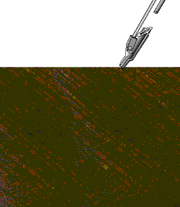
Manta Ray and Stingray anchors offer many significant advantages:
- Fast, easy installation
- Immediate proof test results
- No grout required
- Inexpensive installation equipment
- Environmentally friendly
- No drilling required
- Superior holding capacity
- Anchors for a wide range of soils & applications
The simple, effective, and low-cost Manta Ray and Stingray anchor system represents a major breakthrough in anchoring technology, with a multitude of uses in the utility, civil engineering, and construction markets, including:
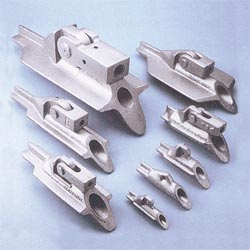
- Utility Poles
- Retaining Walls
- Sheet Piles
- Seawalls
- Pipelines
- Erosion Control
- Underwater Applications
- Blockwalls
- Scaffolding
The Manta Ray and Stingray anchor systems offer a versatile range of anchoring solutions, with eight Manta Ray anchors and three Stingray anchors, each engineered to handle a spectrum of light to heavy-duty holding capacities. These anchors are designed to meet the rigorous demands of various applications, ensuring a perfect fit for every project, no matter the scale.
Displayed below are six distinct Manta Ray anchor heads, each showcasing the innovative design and engineering that goes into these reliable anchors. Crafted from galvanized ductile iron, these anchors are built to withstand the harshest conditions while maintaining superior strength and durability. The anchors are specifically designed to utilize solid steel rods as load-carrying members, ensuring that they deliver maximum stability and support.
All Manta Ray anchors, except for the MR-88 and M-68 models, can be easily driven into the ground using the specialized drive steel set, making installation quick and efficient. Once installed, these anchors can be tested to the desired holding capacity using the load locker, providing immediate confirmation that they are securely and effectively set.
Whether you're securing a light structure or a heavy-duty application, the Manta Ray and Stingray anchors provide the dependable performance you need, backed by the quality and precision engineering that defines these robust anchoring systems.
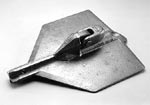
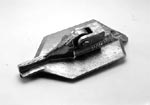
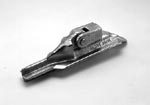
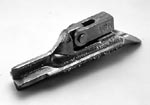
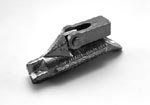
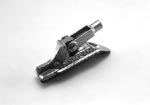
Manta Ray & Stingray Anchor Structural Properties
| Anchor | Structural Safety Factor 2:1 | Diameter** | Part Number | Weight Per Each |
|---|---|---|---|---|
| MR-68 | 2.5 kips (11 kN) | 3/8" - 16 UNC (10 mm) | B8S-03 | 1 lbs. (0.45 kg) |
| MR-88 | 5 kips (22 kN) | 1/2" - 13 UNC (12 mm) | B8S-04 | 2.2 lbs. (1 kg) |
| MR-4 | 8.5 kips (36 kN) | 3/4" (20 mm) | R61-06 | 4.7 lbs. (2.1 kg) |
| MR-3 | 10 kips (45 kN) | 3/4" (20 mm) | R61-06 | 6 lbs. (2.7 kg) |
| MR-2 | 20 kips (89 kN) | 3/4" (20 mm) | R61-06 | 10 lbs. (4.5 kg) |
| MR-1 | 20 kips (89 kN) | 3/4" (20 mm) | R61-06 | 12 lbs. (5.4 kg) |
| MR-SR | 20 kips (89 kN) | 3/4" (20 mm) | R61-06 | 21 lbs. (9.5 kg) |
| MK-B | 20 kips (89 kN) | 3/4" (20 mm) | R61-06 | 85 lbs. (38.5 kg) |
| Sting Ray | Safety Factor | Part Number | Working Load | Weight |
| SR-1 | 45.5 kips (198 kN) | 1-1/8" (28 mm) | R61-09 | 47 lbs. (21.3 kg) |
| SR-2 | 50 kips (223 kN) | 1-1/8" (28 mm) | R61-09 | 66 lbs. (30 kg) |
| SR-3 | 50 kips (223 kN) | 1-1/8" (28 mm) | R61-09 | 91 lbs. (41.2 kg) |
Our Anchor Rods are fully threaded and can be field cut and coupled.
**Anchor Rod Lengths: R61-06 & R61-09 up to 50 feet uncoated. B8S-03 & B8S-04 up to 20 feet.
Recommended: Galvanized rods should be cut to size prior to galvanizing to ensure good nut fit.
Manta Ray Anchor Holding Capacities in Listed Soils
| Common Soil Type Description | Typical Blow Count "N" Per ASTM-D1586 | MR-68 | MR-88 | MR-4 | MR-3 | MR-2 | MR-1 | MR-SR | MK-B |
|---|---|---|---|---|---|---|---|---|---|
| Peat, Organic Silts; Inundates Silts, Fly Ash | 0 - 5 | N.A. | 0.2-0.9 kips (0.9-4 kN) | 0.3-1.5 kips (1.3-7 kN) | 0.8-3 kips (3.5-13 kN) | 2-5 kips (9-22 kN) | 3-8 kips (13-37 kN) | 4-12 kips (18-53 kN) | 6-16 kips (27-71 kN) |
| Loose fine Sand; Alluvium; Soft-Firm Clays; Varied Clays; Fills | 4 - 8 | 0.4-0.8 kips (1.8-3.5 kN) | 0.9-1.5 kips (4-7 kN) | 1.5-2.5 kips (7-11 kN) | 3-5 kips (13-22 kN) | 5-8 kips (22-36 kN) | 8-12 kips (36-53 kN) | 9-14 kips (40-62 kN) | 13-20 kips (58-89 kN) |
| Loose to Medium Dense Fine to Coarse Sand; Firm to Stiff Clays and Silts | 7 - 14 | 0.75-1.25 kips (3.5-6 kN) | 1.5-2.5 kips (7-11 kN) | 2.5-4 kips (11-18 kN) | 5-8 kips (22-36 kN) | 7-10 kips (31-44 kN) | 10-15 kips (44-67 kN) | 14-18 kips (62-80 kN) | 20 kips (89 kN) |
| Medium Dense Coarse Sand and Sandy Gravel; Stiff to very Stiff Silts and Clays | 14 - 25 | 1-1.5 kips (5-7 kN) | 2-3 kips (9-13 kN) | 3.5-4.5 kips (16-20 kN) | 7-9 kips (31-40 kN) | 9-12 kips (40-53 kN) | 15-20 kips (67-89 kN) | 18-20 kips (80-89 kN) | 20 kips (89 kN) |
| Medium Dense Sandy Gravel; Very Stiff to Hard Silts and Clays | 24 - 40 | 1.5-2 kips (7-9 kN) | 3-4 kips (13-18 kN) | 4.5-6 kips (20-25 kN) | 9-10 kips (40-45 kN) | 12-18 kips (53-80 kN) | 18-20 kips (80-89 kN) | 20 kips (89 kN) | 20 kips (89 kN) |
| Dense Clays, Sands and Gravel; Hard Silts and Clays | 35 - 50 | 2-2.5 kips (9-11 kN) | 4-5 kips (18-22 kN) | 6-8.5 kips (27-36 kN) | 10 kips (45 kN) | 15-20 kips (67-89 kN) | 20 kips (89 kN) | 20 kips (89 kN) | 20 kips (89 kN) |
| Dense Fine Sand; Very hard Silts and Clays | 45 - 60 | 2.5 kips (11 kN) | 5 kips (22 kN) | 8.5 kips (36 kN) | 10 kips (45 kN) | 20 kips (89 kN) | 20 kips (89 kN) | 20 kips (89 kN) | 20 kips (89 kN) |
| Very Dense and/or Cemented Sands; Coarse Gravel and Cobbles | 60 - 100+ | 2.5 kips (1 kN) | 5 kips (22 kN) | 8.5 kips (36 kN) | 10 kips (45 kN) | 20 kips (89 kN) | 20 kips (89 kN) | 20 kips (89 kN) | 20 kips (89 kN) |
1 - Drilled hole required to install.
2 - Installation may be difficult. Pilot hole may be required.
3 - Holding capacity limited by working load of anchors.
4 - Holding capacity limited by soil failure.
5 - Not recommended in these soils.
6 - Wide variation in soil properties reduces prediction accuracy. Pre-constructed field test recommended.
Minimum 2:1 Safety Factor Recommended
* Use this chart for estimation only.
* True capacity must be tested with anchor locker.
Stingray Anchor Holding Capacities in Listed Soils
| Common Soil Type Description | Typical Blow Count "N" Per ASTM-D1586 | SR-1 | SR-2 | SR-3 |
|---|---|---|---|---|
| Peat, Organic Silts; Inundates Silts, Fly Ash | 0 - 5 | N.A. | N.A. | N.A. |
| Loose fine Sand; Alluvium; Soft-Firm Clays; Varied Clays; Fills | 4 - 8 | 13-19 kips (58-82 kN) | 19-28 kips (85-125 kN) | 24-37 kips (107-165 kN) |
| Loose to Medium Dense Fine to Coarse Sand; Firm to Stiff Clays and Silts | 7 - 14 | 16-24 kips (72-107 kN) | 27-36 kips (120-160 kN) | 37-48 kips (165-214 kN) |
| Medium Dense Coarse Sand and Sandy Gravel; Stiff to very Stiff Silts and Clays | 14 - 25 | 24-32 kips (107-142 kN) | 31-48 kips (138-214 kN) | 48-50 kips (214-253 kN) |
| Medium Dense Sandy Gravel; Very Stiff to Hard Silts and Clays | 24 - 40 | 29-41 kips (129-182 kN) | 46-50 kips (205-223 kN) | 50 kips (253 kN) |
| Dense Clays, Sands and Gravel; Hard Silts and Clays | 35 - 50 | 39-45.5 kips (173-198 kN) | 50 kips (253 kN) | 50 kips (253 kN) |
| Dense Fine Sand; Very hard Silts and Clays | 45 - 60 | 45.5 kips (198 kN) | 50 kips (253 kN) | 50 kips (253 kN) |
| Very Dense and/or Cemented Sands; Coarse Gravel and Cobbles | 60 - 100+ | 45.5 kips (198 kN) | 50 kips (253 kN) | 50 kips (253 kN) |
- Drilled hole required to install.
- Installation may be difficult. Pilot hole may be required.
- Holding capacity limited by working load of anchors.
- Holding capacity limited by soil failure.
- Not recommended in these soils.
- Wide variation in soil properties reduces prediction accuracy. Pre-constructed field test recommended.
Minimum 2:1 Safety Factor Recommended * Use this chart for estimation only.
* True capacity must be tested with anchor locker.
